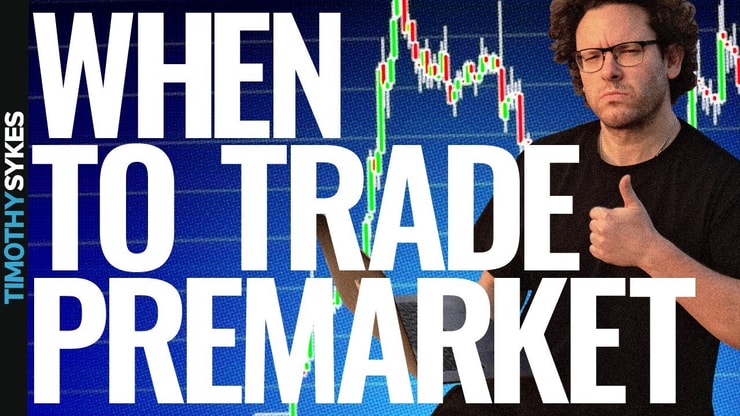Pre-market trading is where the action starts before the market opens — and if you know what you’re doing, it can offer some of the biggest moves of the day.
But let’s be clear: I don’t recommend it for newbies. Low liquidity, wide spreads, and fast moves make it a minefield for undisciplined traders. That said, if you’ve done the work — if you’ve studied the patterns, the catalysts, and your own trading psychology — pre-market trading can be a weapon in your arsenal.
Readers should dive into this article because it offers a comprehensive guide on pre-market trading, detailing its unique opportunities and risks, and equipping traders with strategies for success.
I’ll answer the following questions:
- What is pre-market trading?
- How does pre-market trading work?
- What are the requirements to begin pre-market trading?
- What types of orders are allowed in pre-market trading?
- What are the pros and cons of pre-market trading?
- How does the market environment differ during pre-market trading hours?
- What are successful strategies for pre-market trading?
- How does pre-market trading compare to standard trading?
Let’s get to the content!
Table of Contents
- 1 What Is Pre-Market Trading?
- 2 What Are the Requirements To Begin Pre-Market Trading?
- 3 Pros and Cons of Pre-Market Trading
- 4 Market Environment During Pre-Market Trading Hours
- 5 Successful Strategies for Pre-Market Trading
- 6 Key Takeaways
- 7 Frequently Asked Questions
- 7.1 Does After-Hours Affect Pre-Market?
- 7.2 Is the Pre-Market a Good Indicator?
- 7.3 Can You Buy During Pre-Market Hours?
- 7.4 What Are Key Considerations for Trading in the Premarket?
- 7.5 How Do Various Financial Instruments Impact Premarket Trading?
- 7.6 What Support and Resources Are Vital for Successful Premarket Trading?
- 7.7 How Does the Place of Trading, Such as Nasdaq, Influence Investing Purposes and Strategies?
What Is Pre-Market Trading?
Pre-market trading happens before the regular session kicks off — typically starting at 4:00 a.m. EST and running to the 9:30 a.m. open. This is when stocks can react to earnings reports, press releases, or global news from overnight markets. It’s also when most traders are asleep. That’s why the few who are active can move stocks more dramatically. I trade pre-market only when there’s a clear catalyst and my setup is there. Otherwise, I sit on my hands.
Throughout my trading career, I’ve utilized pre-market sessions to adjust or establish positions based on after-hours earnings reports or international market changes. This trading phase is particularly crucial for those dealing in ETFs, index funds, and individual shares, as it can signal how these securities might perform in the regular session. While it presents opportunities, it’s imperative for traders, especially those new to the scene, to approach pre-market trading with a solid understanding of its dynamics and implications on investments, whether it’s for retirement, an IRA, or more immediate financial goals.
I don’t advise pre-market trading for new traders. If you’re a newbie and you decide to trade the pre-market session, there’s just one rule…
If you buy in pre, you sell in pre.
How Does Pre-Market Trading Work?
Pre-market trading is all electronic — no floor traders, just ECNs matching orders. That’s why volume is thinner and spreads are wider. News drops can cause massive moves … but those moves can reverse just as fast. One of the biggest mistakes I see? Newbies buying in pre and expecting it to keep running when the market opens. That’s a trap.
If you buy in pre, sell in pre. Don’t get caught bagholding.
Understanding the nuances of pre-market trading, from liquidity issues to the impact of global events, is crucial. For traders looking to dive deeper into this area, exploring the benefits and strategies of pre-market trading can be a game-changer. To get a comprehensive understanding of pre-market trading, check out my detailed insights on pre-market trading strategies and benefits.
What Are the Requirements To Begin Pre-Market Trading?

2025 Millionaire Media, LLCTo engage in pre-market trading, a trader must first ensure they have the right setup and resources. This starts with having a brokerage account that offers pre-market trading. You’ll also need to know when their pre-market session starts — for example, Schwab only lets you start trading at 7am EST, while Interactive Brokers will let you trade at 4am EST in many securities.
Traders should be prepared to manage risks differently than they would during regular trading hours, especially considering the potentially lower liquidity and higher volatility found in pre-market sessions.
Here’s the checklist:
- A broker that supports pre-market trading
- Real-time data (delayed quotes = death in pre)
- Fast order entry tools
- Charting you trust
And don’t forget: liquidity is limited. You need to use limit orders only — no market orders in pre-market unless you want to donate to someone else’s P&L.
Brokerage Account
To engage in pre-market trading, you need a brokerage account that offers this service. Not all brokers provide pre-market trading, and those that do may have different rules and functionalities. It’s essential to choose a brokerage that aligns with your trading style and needs.
More Breaking News
- BTC Digital Celebrates Green Mining Milestone in Georgia
- Is LQR House Inc. A Hidden Gem?
- Is Sonnet BioTherapeutics Stock A Hidden Gem?
Minimum Account Balance Required
Some brokers may require a certain account balance to access pre-market trading. This varies and is dependent on the broker’s policies. As a trader, it’s crucial to be aware of these requirements to ensure you have the necessary funds.
Financial Resources Required
Effective pre-market trading requires adequate financial resources. This includes having enough capital to absorb potential losses, considering the heightened risks associated with volatile pre-market conditions.
Types of Orders Allowed in Pre-Market Trading
Always use limit orders in pre-market. This is even more important than during the trading day (although it’s important then too).
Why? Because spreads are wide. If you place a market order, you’re at the mercy of whoever’s on the other side — and that’s rarely in your favor. Set your limit, wait for the price to come to you, and if it doesn’t? Walk away. The best trade is often no trade.
Time Periods for Pre-Market Trading
The specific time frame for pre-market trading varies between brokers, but generally, it starts from the early morning hours until the opening of the regular market session. Knowing these timeframes is crucial for planning trades.
Specific Exchange Rules and Regulations
Different exchanges have unique rules and regulations regarding pre-market trading. It’s important to be familiar with these, as they can impact your trading strategies and execution.
Pros and Cons of Pre-Market Trading
Let’s go down the list…
Pros:
- Trade news catalysts before the crowd wakes up
- Potential to catch a breakout early
- Can lock in profits before the bell rings
Cons:
- Low volume = hard to get filled
- Wide spreads = higher slippage
- No circuit breakers = brutal moves
Market Environment During Pre-Market Trading Hours

2025 Millionaire Media, LLCThe market environment during pre-market hours is distinct from the regular trading session. It’s characterized by less liquidity and, often, higher volatility, making the price movements of stocks, ETFs, and other securities more pronounced. My experience has shown that understanding this unique environment is critical for making profitable decisions, especially when dealing with investments that react sharply to news, such as technology stocks or nascent industries. Traders need to be adept at interpreting indicators and trends in this less predictable environment and should keep abreast of overnight news, earnings announcements, and global events that could affect market sentiment as soon as the regular session begins.
Lowest Prices Available During the Time Period
Pre-market can sometimes offer the lowest prices on stocks, especially if negative news or events have impacted the security.
Wider Spreads & Reduced Liquidity Levels
The pre-market session typically experiences wider bid-ask spreads and reduced liquidity levels. This can lead to more significant price changes for the same volume of trade compared to regular hours.
Electronic Communication Networks (ECN) & Dark Pools
Trades during pre-market are primarily executed through ECNs and, in some cases, dark pools. These platforms match buy and sell orders electronically without using a traditional stock exchange.
Early Morning Volatility in Stock Prices
Stock prices can be particularly volatile during pre-market hours due to thin trading volumes and reactions to overnight news.
Difference Between Regular & Extended Hours Trading Sessions
The main difference between regular and extended hours trading sessions lies in liquidity, volatility, and participation.
Regular sessions have higher liquidity, more stable prices, and greater participation from investors and traders. Extended hours, including pre-market and after-hours, often experience lower volume, higher volatility, and less participation, leading to different trading dynamics.
The after-hours session offers a different set of opportunities and challenges. After-hours trading allows traders to react to news and events that occur post-market close, which can be crucial for staying ahead. However, like pre-market trading, it requires a specific approach due to factors like reduced liquidity and increased volatility. For traders looking to expand their trading window, understanding how to navigate after-hours trading is key. Learn more about effective strategies for trading after hours.
Successful Strategies for Pre-Market Trading

2025 Millionaire Media, LLCDeveloping successful strategies for pre-market trading involves a mix of careful analysis, understanding market indicators, and efficient timing.
I only trade pre-market when three things line up:
- Big News Catalyst — earnings, contract wins, lawsuits, anything with teeth
- Volume — if it’s trading on 10k shares, skip it. I want real volume.
- Clean Chart Pattern — ideally a multi-day breakout or gapping up past resistance
I always check X, chat rooms, and Discord to see where a stock’s momentum is coming from. Pre-market momentum is either fueled by hype or news … if it’s a chat room pump, I want to know what I’m getting into before I start trading.
Don’t chase big green candles in pre. If you missed the move, wait for a dip. Chasing leads to slippage and emotional exits.
Traders should also be aware of the broader economic factors, such as interest rates and mortgage rates, which can impact market sentiment. By combining these tactics with disciplined risk management, traders can navigate the pre-market landscape more effectively.
Conduct Thorough Market Research
Effective pre-market trading begins with thorough market research. Understanding the factors influencing stock prices overnight is essential.
Analyze Overnight News and Events
Keeping a close eye on overnight news and global events is crucial, as they can significantly impact stock prices in pre-market trading.
Set Clear Trading Goals and Limits
Establish clear goals and limits for each trade. This includes setting stop-loss orders to manage risks effectively.
Understand Pre-Market Liquidity and Volatility
Recognize the unique liquidity and volatility characteristics of the pre-market session to make informed trading decisions.
Utilize Technical Analysis Effectively
Employ technical analysis to identify potential trading opportunities and trends in pre-market trading.
Pre-Market Trading vs Standard Trading
Regular market hours are where the big money shows up — institutions, funds, heavy volume. Pre-market is like the warm-up act. It can hint at what’s coming, but it doesn’t always follow through. That’s why I use pre-market for positioning, reacting to news, or locking in early profits — not random guesses.
The stock market has different phases throughout the day, each with its own characteristics and trading volumes. Knowing when to enter and exit the market can significantly impact your trading success. It’s not just about the strategies you employ, but also about timing them right. For day traders, especially those new to the field, understanding these nuances is crucial. Discover more about the optimal times for day trading and how to leverage them for maximum gains in my guide on the best time for day trading.
Key Takeaways

2025 Millionaire Media, LLC- Trade news, not noise
- Use limit orders only
- If you buy in pre, sell in pre
- Don’t chase — let the setup come to you
Trading isn’t rocket science. It’s a skill you build and work on like any other. Trading has changed my life, and I think this way of life should be open to more people…
I’ve built my Trading Challenge to pass on the things I had to learn for myself. It’s the kind of community that I wish I had when I was starting out.
We don’t accept everyone. If you’re up for the challenge — I want to hear from you.
Apply to the Trading Challenge here.
Trading is a battlefield. The more knowledge you have, the better prepared you’ll be.
Do you trade in pre-market? If you do, I want you to write “I promise that if I buy in pre, I’ll sell in pre!”
Frequently Asked Questions
Does After-Hours Affect Pre-Market?
Yes, after-hours trading can impact pre-market sessions as it sets a precedent for early market sentiment and potential price directions.
Is the Pre-Market a Good Indicator?
Pre-market can be a good indicator of market sentiment for the day, especially in reaction to significant overnight news.
Can You Buy During Pre-Market Hours?
Yes, investors can buy stocks during pre-market hours, provided their brokerage account supports pre-market trading and they adhere to the specific rules and requirements of pre-market trading.
What Are Key Considerations for Trading in the Premarket?
In premarket trading, understanding the company’s financial health and recent news is crucial. Keeping track of the number of shares traded during this period can provide insights into market sentiment. Participants in the premarket, including retail and institutional investors, play a significant role in shaping the early market dynamics. Seeking guidance from experts can be beneficial for making informed decisions during these hours.
How Do Various Financial Instruments Impact Premarket Trading?
In premarket trading, liquidity can be influenced by broader financial markets, including the money market and cash flows. Real estate announcements or credit card company reports can impact related stocks. Understanding the nuances of different instruments like CDs (Certificates of Deposit) helps in comprehending market movements in the early hours.
What Support and Resources Are Vital for Successful Premarket Trading?
Access to reliable information is essential for successful premarket trading. Education about market mechanisms and historical data analysis can enhance trading strategies. Considering the impact of loans and broader economic indicators like social security trends can also provide valuable context for premarket activities.
How Does the Place of Trading, Such as Nasdaq, Influence Investing Purposes and Strategies?
The place of trading, especially when it involves major exchanges like Nasdaq, significantly influences investing purposes and strategies. Nasdaq’s pre-market session, known for its technological sector stocks, often sets the tone for how tech stocks will perform during the regular trading hours. Investors using credit cards or loans for investment funding should be cautious, considering the high risks and potential for debt.






Leave a reply